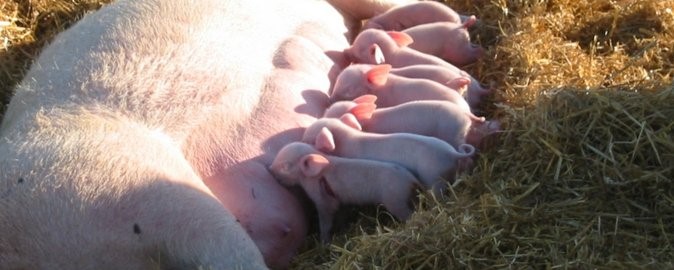Researchers from Aarhus University are collaborating with the industry on developing new feeding strategies and feed products that can improve piglet survival markedly.
August 6, 2018

Studies from Aarhus University in Denmark have shown that more piglets can survive birth and the time thereafter if their mothers are fed closer to farrowing. The right feeding strategy results in a quicker farrowing and thereby stronger newborn piglets, Aarhus said.
The researchers behind this study are now collaborating with the industry to disseminate and apply knowledge about this feeding strategy on commercial farms and to develop new feed products aimed at reducing total pig mortality up to weaning, the announcement said. This will take place in the four-year research project Born2Live, which has been granted 7.1 million Danish krone (DKK) from Denmark's Ministry of Food & the Environment’s Green Development & Demonstration Program.
"If 80% of Danish pig farmers implement this new knowledge, potential additional earnings amounting to at least 139 million DKK can be achieved on the national level," said senior researcher Peter K. Theil, leader of the new research project, with the Aarhus department of animal science.
The aim of the project is to improve the sow’s blood sugar level in order to achieve a quicker farrowing. When the farrowing has a shorter duration, the chances for piglet survival and vitality improve, which, in turn, gives the piglets a good start in life, Theil explained. Short farrowings and high survival rates can be ensured by the right kind of sow feeding the last couple of days prior to farrowing.
In the earlier study, the researchers found that when the sow was fed within the last three hours before farrowing begins, then the farrowing lasted less than four hours, the university explained. If more than three hours passed from the last feeding until the start of farrowing, then the farrowing duration was prolonged and the number of stillborn piglets increased steadily as the time between last feeding and start of farrowing increased.
"The proportion of stillborn piglets was only 3.7% when the sow began to farrow close to the last meal, whereas the national average is 9.4%," Theil said.
The new feeding strategies that the project will develop will ensure quicker farrowings by giving sows more meals. In order to zoom in on the best strategy, the project will test various combinations and levels of meal frequency, amount of feed per meal and new feed compositions, Aarhus said. In addition, the partners will develop new feed concentrate products, including a new wet feed product, to help ensure high blood sugar levels in the sow during farrowing.
"We expect that Born2Live can reduce the proportion of stillborn piglets by 1.5 percentage points and increase survival rates of liveborn piglets by 0.5 percentage points," Theil added.
Partners on the four-year project include Aarhus University, agricultural consulting firm Seges and feed company Vestjyllands Andel.
You May Also Like



